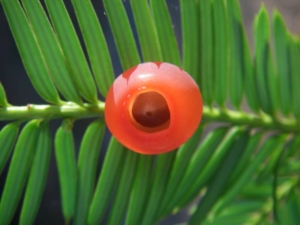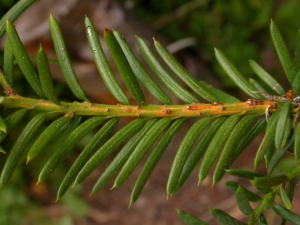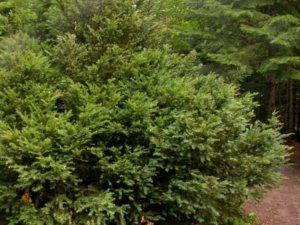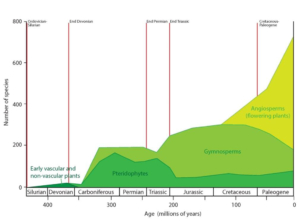Resilience! What Can We Learn from the Pacific Yew
January 19, 2025
We will face challenges in our future. Will we stay rooted when we feel torn apart, burned out, stepped on, whipped by the wind, undernourished, out in the cold, sick from the pollution? How long will we last? These challenges might be figurative for humans but plants face them quite literally throughout their lives. What can plants teach us?
I asked my botany kin which plant best represents resilience. From the list, the Pacific yew (Taxus brevifolia) was not familiar to me but I was curious to find out more. Frankly, I couldn’t stop reading about it!
Scientists take interest in the lineage of the Taxus genus because the species within the genus show an adaptive evolution. That might be obvious considering that the ancestor of the Taxus genus is the oldest recognizable Triassic fossil and is believed to date back 200 million years. The Taxus genus itself is still an ancient species, originating approximately 67 million years ago (mya) and Taxus brevifolia, our local treasure, 29 mya. This means that Taxus survived through the explosions, shifts, eruptions, shakes and freezing/warming spells of several extinction events. Will humans do as well if our communities get rocked?
Check the Calendar Page
for work parties
Please email to volunteer
freewayestatescommunityorchard@gmail
The Pacific yew is an understory evergreen conifer found mostly in the Maritime Northwest from southern Alaska, to northern California, and also in northern Idaho. The abundance of Taxus is associated with three shade-tolerant, late-successional species: grand fir (Abies grandis), western red cedar (Thuja plicata), and western hemlock (Tsuga heterophylla). Pacific yew is usually a long-lived medium-sized tree. If the yews are about as old as the forests in which they grow, scientists estimate that their ages can be 350 to 650 years! Clearly not a pushover plant.
In addition to the resistance trait of adaptability, the yew, along with 90% of other plants, belong to a special mutual aid society – mycorrhizae. Through the reciprocal relationship with mycorrhizal fungi the yew plant roots essentially expand far beyond their root zone to receive additional nutrients and water. In return, the yew roots put out cookies (exudates) that benefit the fungal community.
Native peoples of the Pacific Northwest Coast have a close relationship with the yew and consider the wood very valuable, using it for implements that require strength and toughness. Nearly everyone who could collected or traded for it to use for bows (its Haida name means bow-plant). Yews also have many medicinal uses, many of a magical nature.
For many years, these trees were harvested to make the chemotherapy drug taxol. Recent advances in the production of synthetic taxol make it less likely that wild yew populations will continue to be exploited. Nevertheless, concerns about logging practices continue to make the Pacific yews a bit nervous. The area of old-growth forest, where Taxus is found in substantial numbers, has declined more than 50% in the last 50 years.
Will our yew last another 30 million years? Well, I won’t be around to watch. In the meantime, when I come upon a Pacific yew, I will step closer to bathe in its resistance.
Ruth
Notes:
Lushootseed Name: c̓əx̌bidac (pronounced tch-uch-bih-dotz)
To see a Pacific yew in Seattle, visit Seward Park. There is a large yew in the location 47.559° N, 122.252° W (off of Hukleberry trail). There are yews in Discovery Park also.
Other PacificYew locations:
UW – A native yew specimen is located on the southwest corner of the Winkenwerder Forestry lab. It is planted beside a much larger but similar looking Coast Redwood.
Also, UW botanical garden – South end of the Arboretum above Azalea Way (Grid 17-1E)
https://botanicgardens.uw.edu/washington-park-arboretum/visit/maps-trails/
https://depts.washington.edu/uwbg/gardens/map.shtml
Pacific yew taxonomy:Eukaryota (domain); Plantae (kingdom-plants); Viridiplantae (clade/subkingdom-green plants); Streptophyta (phylum/infrakingdom-land plants & green algae); Pinopsida (class-conifers); Pinales (order-pines); Taxaceae; (family-yews); Taxus (genus); Taxus brevifolia (species)
—–
References
https://www.mdpi.com/1999-4907/13/10/1590
Plastome Phylogenomics Provide Insight into the Evolution of Taxus
Xiaoming Jia, Shijing Feng, et al, Forests 2022, 13(10), 1590; https://doi.org/10.3390/f13101590
https://www.srs.fs.usda.gov/pubs/misc/ag_654/volume_1/taxus/brevifolia.htm
Pacific Yew Taxus brevifolia Nutt. (information sheet)
https://www.sciencedirect.com/science/article/pii/S0921818114001477
The global vegetation pattern across the Cretaceous–Paleogene mass extinction interval: A template for other extinction events
Vivi Vajda, Antoine Bercovici, Global and Planetary Change, November 2014, Volume 122, Pages 29-49
“https://escholarship.org/content/qt7bp3h016/qt7bp3h016_noSplash_d2ba231263a025760315df5978f3821d.pdf
Advancing the plant fossil record across the Permo-Triassic boundary with a focus on phytoliths
Renske Kirchholtes, Fall 2018, Dissertation, University of California – Berkeley
https://besjournals.onlinelibrary.wiley.com/doi/10.1046/j.1365-2745.2003.00783.x
Taxus baccata L.
P. A. Thomas, A. Polwart, Journal of Ecology (British Ecological Society) First published: 14 May 2003,





looks like there are 5 or so at the UW arboretum too! i am excited to check them out. and i think that like other yews they are pretty poisonous! but the red berry-like part is sweet and can be eaten with great caution/mindfulness because the black pit inside is poisonous.
what a cool plant! im curious about medicina uses. it would be a fun one to plant, too.
i searched here: https://depts.washington.edu/uwbg/gardens/bgbase.php?txtSearch=Taxus+brevifolia&submitedits=&_submit_check=1
Pacific yew (in contrast to other yew species) contains minimal amounts of taxine alkaloids. Alkaloids (a class of terpenoids) are the principal toxins associated with yew poisoning. (The aril (seed cover) is non-toxic.) This allkaloid is important to the plant and functions as a defense against pests, herbivores and phytopathogens.
Ruth
very interesting, Ruth. Thank you !